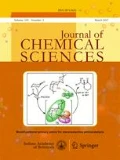Abstract
Molecular structure of phosphine in a number of excited electronic states is studied using the method of hole-potential within the basic framework of CNDO/2 theory. Effects of including 3d-functions of phosphorus in the basis set on computed molecular geometries, transition energies and inversion barriers in the excited states have been investigated. An attempt is made to rationalise qualitatively the structural changes in the excitedstate in terms of Walsh-type correlation diagram constructed with the eigenvalues of the Fock operator in theV N-1 potential model. A simple orbital model for predicting the nature of structural changes in the excited states is proposed.
Similar content being viewed by others
References
Banerjee M and Bhattacharyya S P 1979J. Phys. Chem. (In Press)
Humphries C M, Walsh A D and Warsop P A 1963Discuss. Faraday Soc. 35 148
Huzinaga S and Arnau C 1970Phys. Rev. 1 1285
Huzinaga S and Arnau C 1971J. Chem. Phys. 54 1971
Norman Jr J G 1974J. Chem. Phys 61 4630
Petke J D and Whitten J L 1973J. Chem. Phys. 59 4855
Pople J A, Santry D P and Segal G A 1965J. Chem. Phys. 43 S129
Veillard A 1975 InQuantum mechanics of moleculer conformations (ed.) B Pullman (New York: John Wiley) p. 63
Walsh A D 1953J. Chem. Soc. p. 2260
Author information
Authors and Affiliations
Rights and permissions
About this article
Cite this article
Banerjee, M., Bhattacharyya, S.P. Change of molecular structure in the excited states: A (CNDO/2) hole-potential study on phosphine. Proc. Indian Acad. Sci. (Chem. Sci.) 89, 549–559 (1980). https://doi.org/10.1007/BF02881089
Received:
Revised:
Issue Date:
DOI: https://doi.org/10.1007/BF02881089




